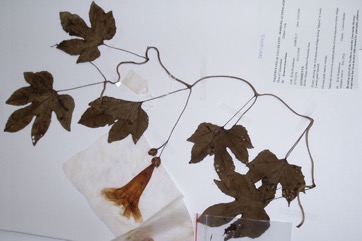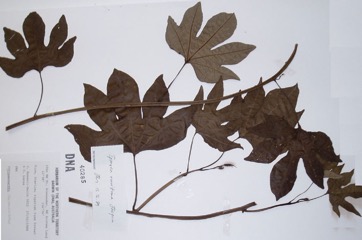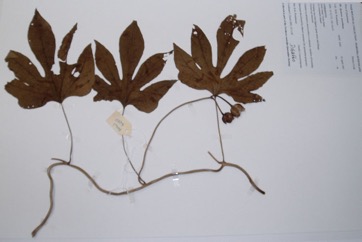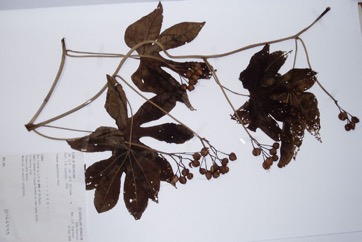Palmate Morning Glory

It is a tropical plant growing in rainforest and coastal shrub. It suits humid locations. It grows throughout the tropics. Plants need a well drained soil and a sunny position. They can only tolerate light frosts. In Africa it grows between 20-2,440 m above sea level. In Zimbabwe it grows up to 1,000 m above sea level. It suits hardiness zones 9-12. In Yunnan.
Also known as:
Bhui khola, Canhano, Enhano, Large forest ipomoea, Natal cotton plant, Nhambi-di-mato, Qi zhao long
Synonyms
- Batatas paniculata (L.) Choisy
- Convolvulus paniculatus L.
- Ipomoea paniculata (L.) R. Br.
Edible Portion
- Tubers, Root, Leaves
Where does Palmate Morning Glory grow?
Found in: Africa, Asia, Australia, Benin, Burkina Faso, Cambodia, Central Africa, Central African Republic, CAR, China, East Africa, Fiji, FSM, Gabon, Guiana, Guianas, Guinea, Guinée, Guinea-Bissau, Guyana, India, Indochina, Indonesia, Japan, Kosrae, Laos, Malawi, Malaysia, Micronesia, Mozambique, Myanmar, New Caledonia, Pacific, Papua New Guinea, PNG, Philippines, Sao Tome and Principe, SE Asia, Sierra Leone, South Africa, South America, Southern Africa, Sri Lanka, Suriname, Taiwan, Thailand, Venezuela, Vietnam, West Africa, Zambia, Zimbabwe
Notes: There are about 500 Ipomoea species.
Status: Not a significant food plant.
Growing Palmate Morning Glory
Cultivation: Plants can be grown from seed or cuttings.
Edible Uses: Starch is extracted from the roots. The tuber is eaten as a vegetable.
Nutrition Info
per 100g edible portion| Edible Part | Energy (kcal) | Protein (g) | Iron (mg) | Vitamin A (ug) | Vitamin c (mg) | Zinc (mg) | % Water |
|---|---|---|---|---|---|---|---|
| - | - | - | - | - | - |
Palmate Morning Glory Photos




References
Achigan-Dako, E, et al (Eds), 2009, Catalogue of Traditional Vegetables in Benin. International Foundation for Science.
Bodkin, F., 1991, Encyclopedia Botanica. Cornstalk publishing, p 584
Collectanea 4:216. 1791 ("1790"); Hort. schoenbr. 2:37-38, t. 200. 1797 - = I. digitata auct. pl.
Cundall, P., (ed.), 2004, Gardening Australia: flora: the gardener's bible. ABC Books. p 738
Dansi, A., et al, 2008, Traditional leafy vegetables and their use in the Benin Republic. Genet Resour Crop Evol (2008) 55:1239–1256
Elliot, W.R., & Jones, D.L., 1990, Encyclopedia of Australian Plants suitable for cultivation. Vol 5. Lothian. p 430
Fang Rhui-cheng; George Staples, CONVOLVULACEAE Flora of China
Hu, Shiu-ying, 2005, Food Plants of China. The Chinese University Press. p 639
Jadhav, R., et al, 2015, Forest Foods of Northern Western Ghats: Mode of Consumption, Nutrition and Availability. Asian Agri-History Vol. 19, No. 4: 293-317
Jones D, L, 1986, Ornamental Rainforest Plants in Australia, Reed Books, p 291
Lim, T. K., 2015, Edible Medicinal and Non Medicinal Plants. Volume 9, Modified Stems, Roots, Bulbs. Springer p 48
Low, T., 1992, Bush Tucker. Australia’s Wild Food Harvest. Angus & Robertson. p 8
Nicholson, N & H., 1994, Australian Rainforest Plants 4, Terania Rainforest Publishing. NSW. p 43
Pickering, H., & Roe, E., 2009, Wild Flowers of the Victoria Falls Area. Helen Pickering, London. p 54
Smith, A.C., 1991, Flora Vitiensis Nova, Lawaii, Kuai, Hawaii, Volume 5 p 63
Townsend, K., 1994, Across the Top. Gardening with Australian Plants in the tropics. Society for Growing Australian Plants, Townsville Branch Inc. p 266
Williams, K.A.W., 1999, Native Plants of Queensland Volume 4. Keith A.W. Williams North Ipswich, Australia. p 236
World Checklist of Useful Plant Species 2020. Royal Botanic Gardens, Kew